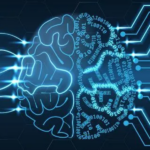Are you looking for a way to build and manage your business smartly? Do you want to find the latest technologies that will help you expand your business? Today, competition in the IT market has increased exponentially. Every enterprise needs to keep an eye on strategies or technological advancements that help it stay ahead of its competitors.
What can they do to enhance themselves? What’s the answer? Artificial intelligence is the answer. AI model development is affecting companies worldwide, helping them expand in ways that the rest of humanity has not thought of previously. Firms that invest in Artificial Intelligence solutions are more likely to be successful or better on the market over the coming five years.
According to research according to statistics, according to statistics, the AI sector is witnessing incredible growth over time, and over 80% of businesses are embracing AI in one way or another. A quarter of companies are currently testing AI or are planning to try AI. 40% of firms invest in AI solutions. A few are creating AI technology on their own. Thus, artificial intelligence is changing business practices in every aspect and will soon become the new technological frontier for growth.
Are you trying to figure out whether you could experience the advantages of AI for businesses? How do you develop innovative AI models that will help improve your company? This article will provide tips on integrating and developing AI models for your company.
What Is An AI Model?
An AI model can be described as a computer-based program that analyzes data to make connections. It must be fed data and taught to identify patterns and connections to work effectively. Special AI models can make the outcome practical in virtually any circumstance in the entire industry.
The principal reason an organization decides to develop an AI model is to conduct sophisticated analyses. This allows the models to make data-driven, well-informed decisions and forecasts at a moment’s notice. At the heart of AI models are super-smart computers whose algorithms act as the mental engines behind them. They allow them to move through massive amounts of data with astonishing effectiveness and accuracy.
To fully comprehend what constitutes the definition of an AI model, it’s crucial to understand the fact that AI models come with an array of technology, which includes:
Machine Learning
AI models are built on the fundamentals of machine learning development, an area of artificial intelligence that allows the computer to acquire knowledge from information. By using iterative methods, they establish their knowledge of information and aim to increase their capacity to make exact predictions and make decisions.
Natural Language Processing (NLP)
When it comes to text and language data, AI models employ sophisticated NLP techniques to understand human language, deduce semantic meanings, and create human-like reactions. They also allow users to participate in complex conversations, provide customer support more automatically, and process texts with incredible precision.
Neural Networks
AI models usually utilize the power of neural networks, which have been influenced by the structure and functions of humans’ brains. Neural networks comprise interconnected nodes that can process information hierarchically and in parallel. This design also allows it to deal with complex relationships between data.
Enterprise AI Architecture: The Five-Layer Model
Are you looking to introduce AI solutions in your company? When creating an AI solution, it is essential to include AI layers. They all play vital roles in making an efficient and successful AI deployment possible. We’ll explore the layers to discover their significance.
Infrastructure Layer
It’s the core layer of the enterprise AI architecture. The infrastructure layer supplies the necessary computing power to complete AI tasks in a speedy manner. The infrastructure layer comprises hardware components such as servers, Graphics Processing Units (GPUs), and other devices.
This is the part in which we create the hardware infrastructure that allows data analysis and processing for the company’s AI system. To clarify things, enterprises have the option of choosing from a variety. of easy-to-scale and simple-to-adopt solutions for infrastructure on cloud platforms like AWS, Google Cloud, and Azure.
Data Layer
It is possible to think of this section as the warehouse storing all essential materials. In the same way, the data layer helps us gather, store and manage the information needed to carry out AI tasks. The data could comprise the customer’s information as well as sensor data generated by the manufacturing process.
In this case, data passes through pre-processing stages like refinement, transformation, and standardization to ensure the integrity and accuracy of the data. Warehouses or data lakes are typically used to efficiently handle vast data.
Service Layer
You must now implement your Artificial Intelligence models so they will begin to function properly. This is the point where the service layer comes into the equation. When it comes to AI, the service layer allows the system to implement and control custom AI model development within real-world applications.
Furthermore, it includes the creation of APIs that allow various platforms to interact with AI models. This includes activities like monitoring, scaling, and deploying models. Containers and microservices in architectural designs are frequently employed to speed up the deployment and administration process.
Model Layer
Then, let’s take a closer look at the process of constructing and educating AI models. The model layer is where engineers and data scientists select algorithms and design neural networks using labeled data from the modeling layer. The models are designed to grow and evolve over time, applying methods like optimization and hyperparameter tuning. Popular machine learning tools like PyTorch or TensorFlow are frequently used in this stage.
Application Layer
Finally, we verify the AI model’s capabilities in real-world situations, and this is where the application layer comes in. The application layer requires the integration of AI in business software, systems, and procedures. It could involve using AI-generated forecasts to improve processes in supply chain management, understanding the fraudulent nature of the financial transaction, personalizing for the user/customer experience, and so on. The goal is to use AI knowledge to make the right decisions that will result in better company results.
Advantages Of Investing In Smart AI Models
Intelligent AI models are becoming essential elements in today’s competitive business world. They can process massive volumes of data, automate operations, and implement decisions based on data, which allows organizations to excel in an aggressive business environment. Businesses can unlock new possibilities, enhance the customer experience, and sustain growth by carefully implementing and leveraging the power of AI models.
Data-Driven Decision-Making
Smart AI models are a valuable tool for business as they analyze huge amounts of data and provide important insight. They can help make data-driven decisions which helps organizations make better choices, design successful strategies, and spot the newest patterns.
Efficiency And Automation
Smart AI models can automate routine activities and processes, lowering the load on human resources. They handle routine jobs with precision and consistency and free employees to concentrate on their higher-level strategic and creative elements.
Customer Engagement And Personalization
They allow businesses to offer highly personalized customers with highly personalized services. Based on the analysis of customer behaviour and preferences, intelligent AI models can suggest specific products, customize marketing campaigns, and provide 24/7 assistance.
Predictive Analytics
Smart AI models can accurately predict the future and results. This is crucial in managing inventory, optimizing supply chain processes, and financial planning. It helps companies avoid costly disruptions and maximize resource allocation.
Risk Management
AI models are important in assessing and managing risk in fields like insurance and finance. They can analyze past data, identify potential risks, and recommend minimizing negative outcomes.
Cost Savings
The latest AI models and technologies have drastically reduced operating costs by reducing labor-intensive processes and distributing resources more efficiently. In the course of time, the effective implementation of AI models in companies has led to a variety of advantages for companies with large scales.
Offers Competitive Advantages
Creating an AI model can give businesses an edge over competitors by allowing them to stay ahead. AI technology and software allow for new product development and business models that increase long-term growth potential.
How To Create An AI Model For Enterprises
As you develop AI models, do not become absorbed in thoughts of obscure code or complex algorithmic processes. Suppose the time is right for you to tackle these challenges. In that case, they are handled by competent experts and custom AI development firms.
Following the instructions below, you’ll begin creating the AI Model explicitly designed for integration into your company.
Identifying Problems And Objectives
The initial step when creating the AI system for your company must be to identify your goals of the AI program. What issues do you want to address, or what shortcomings do you hope to correct? Identifying these issues will help you establish a strong base to guide the development of the AI Model. Invoking the assistance of an expert AI development business is an ideal way to start the process if you can’t provide the necessary expertise to your company.
Collection and Preparation Of Data
Data is the nutrient that powers your AI, and the accuracy of the data you provide in your AI model is directly related to the accuracy of the output. Your data should not just be relevant to the AI model’s future uses; nevertheless, it must be properly curated. Once you’ve collected and sorted the data, it can be divided into validation, training, and testing sets to increase effectiveness in the subsequent test phase.
Committing To An Algorithm
Similar to how data forms the heart of the AI model the algorithm itself is an element of the model. Again, the kind of algorithm you pick depends on the context of your requirements and the use case.
Based on whether you’re working with structured or unstructured data, it is possible to choose an algorithm that is suited to one or the other. In addition, Machine Learning (ML) is a key component of AI models. It is essential to think about the many ML varieties at this time. Also, you can consider using a deep-learning algorithm.
Training Your AI Model
When you’ve selected the algorithm you want to use and have set up your data, it’s the time to begin training an AI model. This is when the data you use for training is in play. It is important to integrate this into your AI algorithm until the model can account for the variances in the information. It will take gradual modifications in the AI model’s internal parameters, and ultimately, make the necessary adjustments to the hyperparameters.
Assessing Your AI Model
After the initial training phase is completed, you can use your validation data collection to measure the model’s performance. The most appropriate measures for scoring AI models will depend on the kind of model employed and the model’s characteristics, but in general, you should examine precision, accuracy recall, and F1 score.
Testing And Deployment
After you’ve evaluated your AI algorithm’s accuracy and made the required adjustments, you’ll move into the test phase. Your testing model to recreate real-world conditions and the environments where the model is expected to function. At this point, you’ll have confidence in its accuracy. However, certain minor changes may have to be implemented. After the AI model can hit all its goals, it’s time to implement it.
Ongoing Monitoring And Evaluation
Like any software, knowing that the development process will never be finished is essential. While your AI model functions in real-world settings, you should constantly observe its development and identify the flaws or errors within its functions. Regular evaluations of its performance are required, and any future updates must be planned to upgrade the AI model over time. Be aware that the more the AI model is used in real-world situations, the greater the chance for improvement.
Factors Affecting the Cost To Build An AI Model
There are various factors that affect the cost to develop AI models for enterprises. Some of them are:
- The price of building the AI model can be influenced by several variables, such as the model’s complexity level, the level of customization needed, and the number of resources required.
- The cost of creating an AI model will depend on the amount of detail and the needs. A shelf-sale AI model could be an option that is more affordable and comes with a price dependent on the provider as well as the options offered.
- The expense of software used to construct an AI model is variable. This is the case for AI software development platforms, programming tools, and other software elements required to build and run an AI model.
- Creating the prototype AI model involves an initial concept design and the execution of the model, which includes data collection and processing algorithms and tests.
- AI models need regular maintenance to maintain their efficiency and precision. This includes periodic adjustments, bug fixing, and monitoring and optimizing the model to ensure it is current and operating efficiently.
Things To Take Into Account While Developing An AI Model For An Enterprise
AI model development process needs careful consideration of various aspects to guarantee success. From the quality of data and keeping ethical issues at bay, a myriad of factors are a part of the AI model’s development process. Below are some key aspects businesses should be aware of when traversing the maze of AI modeling:
The Structure Of AI models
Enterprise AI models require substantial computer resources. Investing in scalable infrastructures is crucial for ensuring that the model is properly managed during training and deployment. Cloud-based options like Azure, AWS, and Google Cloud are known for their flexibility and capacity to scale.
Data Collection
Suppose you have decided to construct your AI model. In that case, it is crucial to ensure that the data used in training the AI model has been legally obtained and with permission. Use robust security measures to guard sensitive information against security breaches and unauthorized access. Security measures for access control and encryption are vital.
Regulatory & Ethical Compliance
Data from enterprise systems often contain sensitive data. Make sure that the team developing your AI model has taken strong security and privacy measures to secure sensitive data when developing the AI model that the company will use. Be sure to comply with data ethics and privacy laws to minimize reputational and legal dangers.
Scalability & Integration
Think about scalability in the design of your AI model so that it can scale up to the future as increasing volumes of data are generated. Be sure the company’s existing workflows and systems can be integrated seamlessly.
Generative AI
The phrase “Generative AI” describes an area of artificial intelligence that has gained popularity within the past five years. Certain models, like ChatGPT, can create pictures, text, and even codes independently. This is a sign of an impressive advancement in AI capabilities.
Generative AI also equips companies with modern methods for automating content creation, automation, and problem-solving. Through generative AI, businesses can reach new productivity, creativity, and uniqueness levels with their products and services.
Transparent Data Handling
Concerning ethical questions like unfairness, prejudice and transparency is a part of the umbrella of transparent handling of data. Put the appropriate techniques in the place. You will reduce the bias of training data and make decisions. You can also ensure ethical and responsible usage of AI. Creating a welcoming digital ecosystem is possible by fostering confidence, accountability, and fairness within AI models.
Integration Challenges In AI Model Deployment.
Integrating AI models into current enterprise infrastructure can be difficult. It requires careful analysis of many factors to ensure an uninterrupted interaction between AI models and the current infrastructure. One of the most effective ways to overcome this integration challenge is to use API-driven integrations.
API-driven integrations are essential in helping facilitate the exchange of data and other information between AI models and current AI systems. APIs (Application Programming Interfaces) offer a standard means for different software to exchange information with each other. Companies can create secure and efficient communication through APIs, allowing information and data to flow smoothly.
An adaptable and modular structure is one of the most important aspects of overcoming integration issues. The modular design ensures the AI models are broken down into separate components, making incorporating them into systems already in place simpler. This method allows flexibility and scaling, which enables companies to adapt and grow their AI deployment when needed.
Additionally, collaboration across functional teams is essential to understand what integration is required and in addressing possible problems. Participating the stakeholders of IT, data science, software engineering, and business analysts can help ensure that they have a complete knowledge of the integration landscape. With the help of collaboration, businesses can align their efforts and accelerate the deployment process.
To illustrate the importance of addressing integration issues, consider a case study of a manufacturing firm that intends to use AI models to improve production procedures. The company’s existing system includes several components, including inventory management, supply chain management, and quality controls.
Integrating AI models in this complex system demands a thorough study of the data flow, API compatibility, and potential security threats. By integrating APIs, a modular design, and cross-functional collaboration, a business can efficiently incorporate AI models that increase production efficiency and reduce costs.
Top Forces Driving AI Model Development
Various factors that influence the creation of AI models also influence the direction AI-based applications are expected to take in the near future. Business owners should consider these elements when making decisions on AI design models. Some of the most influential factors in the development of AI models as well as business decision-making include:
Advancements In ML Algorithms
Machine algorithmic learning is the foundation in the creation of AI models. Business owners can use these techniques to build higher-quality and more precise AI models. Modern advances in machine-learning which have enabled AI models to detect patterns and predict future events, which include:
- Deep learning
- Rewarding learning
- Transfer learning
The methods used have greatly increased the capability of AI models, which allows them to be more advanced and accurate. Utilizing these advances in machine learning, business owners can create effective AI models that will automate processes, improve operations, and offer valuable information to help make business decisions.
Rise In Computational Power
The development and use of AI models require a lot of computing capacity. Access to computing resources has allowed entrepreneurs to develop more sophisticated AI models capable of processing larger sets of data and making more accurate forecasts. The advent of specific technology, such as Tensor Processing Units (TPUs) and Graphics Processing Units (GPUs), has dramatically increased the creation of AI models. These hardware systems can run complex calculations in parallel, allowing AI models to be developed much faster and more efficiently.
The increased power of computation opens up new opportunities for entrepreneurs looking to utilize AI for their operations. This allows them to take on greater challenges and make better decisions based on data.
Ethical Ramifications
As AI technology becomes more widespread, ethical concerns about its impact are rising. Incorrectly designed and properly trained AI algorithms can create biases or discriminate against certain populations. Alongside navigating the complex legal frameworks for intellectual property liability, liability, and data security, companies have to consider ethical consequences for the use of AI models.
Ensuring that AI models are trustworthy, transparent, and ethically accountable is vital. Companies must be proactive in dealing with the issues of bias and ethics associated with AI models and ensuring they’re used fairly and impartially. This way, companies can establish confidence with their clients and other stakeholders and reduce liability for legal and reputational risks.
Higher Data Availability
As the digital revolution has exploded, technology and data are now all-encompassing in society and businesses. Business owners can use this information to develop AI models to detect patterns, predict, and even automate processes. To be successful, entrepreneurs should ensure the information they are using is reliable, complete, and impartial. Also, they must be aware of privacy and data security concerns and follow the regulations governing data privacy.
Data privacy laws differ across diverse areas. Therefore, entrepreneurs should ensure they adhere to the correct guidelines and rules when gathering, storing, and processing information. If they take a sensible approach to managing data, businesses can benefit from AI’s potential and safeguard the security and privacy of individuals’ data.
Conclusion
Developing smart AI models is an extremely complicated task, as it demands expertise in data science, expert knowledge in the field, and expertise in the domain. Therefore, before beginning the process of developing AI models, companies should ensure that they have all tools readily available because it could be difficult for developers to function without the right tools, such as a sufficient quantity of data, the right learning models as well as AI expertise in development.
Companies must know their goals and the services they want to give their clients to create the AI model. Creating the proper plan for the AI modeling process is crucial to making the whole process smooth and productive. Whether you’re in the startup phase or managing a massive enterprise continuous learning, prioritizing new technologies and AI developments is essential for staying ahead of the competition.








